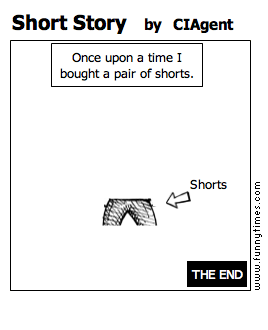I’m currently striking a good balance between my novel outlining and my short-story work. The former excites me, but eventually I itch to simply write something; and the latter allows me an outlet for that.
However, as I mentioned, I don’t tend to try and outline my short stories much. It’s simply not the way I’ve gone about it. But of course, as soon as I try outlining and then try writing a short story in the same way I’ve been writing them for years, it doesn’t work, and I grind a promising little sci-fi story into the dirt.
The problem isn’t the story, and it isn’t even the conclusion. In truth, the tale as it’s told feels right, and if I was presenting it in the third-person I think it would have worked fine. But it’s told in the first person, and at about two thirds of the way in, having completed their task, the narrator is suddenly — and by necessity, within this tale — cut from the action. The end result is, while the story finishes up quite nicely in theory, I suspect that the experience of reading it will be disappointing, with the build-up and excitement ultimately killed by a “Later, I heard that this happened, and that happened” kind of conclusion. It falls foul of Telling Instead Of Showing, which is one of the Prime Evils of fiction writing. As with all the rules, of course, there are times to throw it aside and ignore it, but this isn’t one of them. In this case, it would absolutely be better if the reader were shown what happened, rather than hearing about it in the aftermath.
I have two options at this point. One, I can step back and try to outline a new ending to it — something I normally avoid, but it wouldn’t require a great deal of work. The amount of outlining in a five-thousand word short story doesn’t come close to the outlining required in a hundred-thousand plus word novel. But the alternative is that I could shift to a secondary narrator at that point, so that the action is again presented from the first person. If I can forge a believable connection between the two narrators — and now that I’m sitting here writing this out, I think that I can do exactly that — I may well be able to bring the story to its conclusion in the same fashion, but while making the writing altogether more interesting.
This is one of those cases where writing out the blog post has been a help to my actual writing, because I didn’t consider this possibility earlier. But I already have the character I need to hand for the transition, a perfect choice for presenting the action, and I have already hinted at the connection within the conclusions of the tale. And now I know where I’ll be taking this story, which is something I didn’t know when I first began. Generally speaking I avoid transitions between first-person narrators, as historically I haven’t liked them; but mostly, I think the transitions I’ve seen have seemed frivolous, serving little purpose. But in the case of this story it feels necessary, and I think it will work.
So that’s where I’m at today. My first drafts of short stories are often close to what I want; but in this case, while the story feels right, the writing was painfully wrong. This afternoon, then, I’ll return to this story; and at the point where the narrator is cut from the action, I’ll transition to the second narrator instead.
Hurrah!

Leave a comment